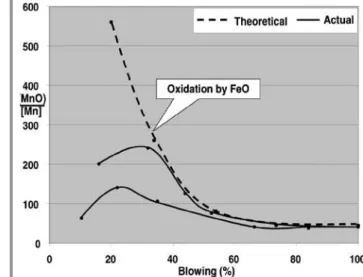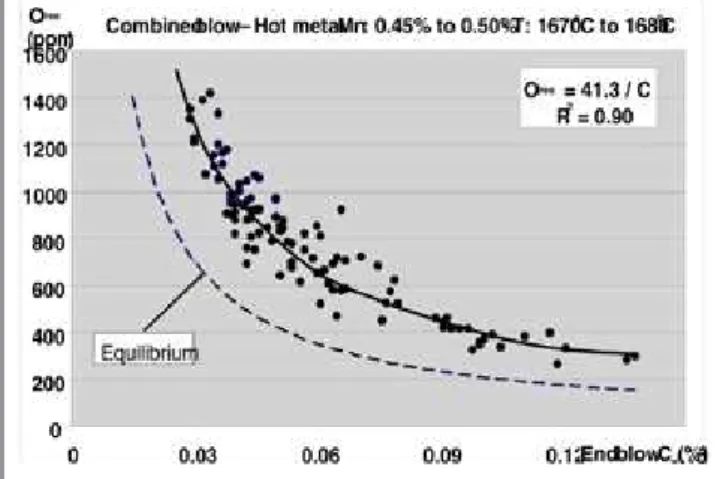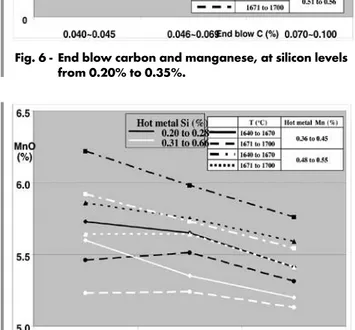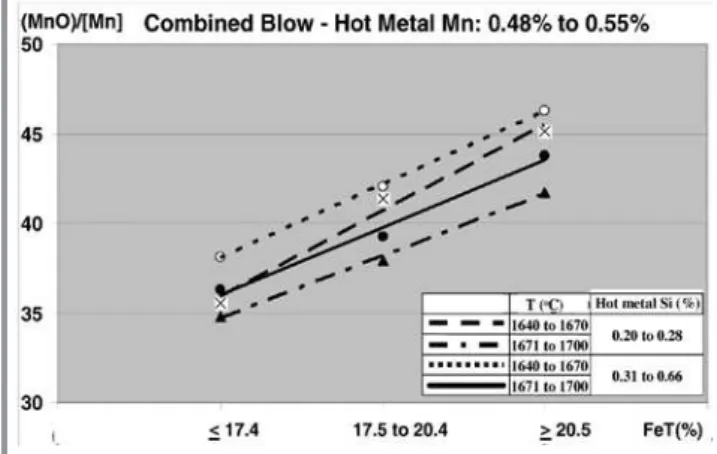La Revue de Métallurgie - CIT - Novembre 2008 556
T
he end blow manganese behaviorin BOF process has been assessed through
analysis of an industrial data base.
The available literature suggests that
the main operational factors to influence
the end blow manganese behavior
in BOF are: manganese input, slag volume,
oxidation level and temperature.
The large extension of the industrial data
base has made it possible to separate
the influence for each factor.
Then correlations between end blow
manganese and these factors have
been obtained.
INTRODUCTION
Manganese is required for most steel grades and is a residual for many others. Manganese has been added to steel for deoxidation and desulfurization purposes and it is the most important alloying element except carbon. As a consequence of that iron-manganese is widely employed at steelmaking shops and makes for more than 90% of all employed manganese (1). One reason for pursuing higher manganese content at blow end would be costs saving since less iron-manganese alloy would be added in the ladle. However Interstitial Free (IF) grades require very low manganese content, say around 0.10% to 0.20%. This implies very tight process control in order to meet the specifications.
MANGANESE OXIDATION
Manganese oxidation in the converter is made by direct oxygen oxidation or by iron oxide indirect oxidation as follows:
[Mn] + [O] = (MnO) [1]
(FeO) + [Mn] = {Fe} + (MnO) [2]
Equilibrium condition at reaction interface, equation
[1] gives:
[3] and for manganese content:
[4]
X stands for molar fraction,
γ
for the Raoultian activity coefficient and f for the oxygen Henryan activity coefficient.According to equation [4] increasing activities of MnO (aMnO = XMnO.
γ
MnO ) would lead to increasing steelmanganese yields thus saving costs. Slag manganese oxide content (XMnO) can be increased by higher
STEELMAKING
According to Liao et al (2) the higher the silicon input the higher the slag volume and the smaller the MnO content (by simple dilution). However this would not translate to increasing manganese oxidation since the higher silicon content is followed by FeO dilution and temperature increases. Thus one observes a smaller manganese slag/metal partition coefficient value.
Of course the equilibrium constant is dictated by temperature only. Also the manganese oxidation reaction is exothermic meaning higher equilibrium constant values with decreasing temperatures. From a thermodynamic viewpoint higher temperatures would lead to higher manganese recovery.
Equation [4] also shows that smaller values of Henryan activities coefficients fMn and fo, are favourable to higher manganese recovery. However the practical effects of these variables seem negligible when the interaction coefficients are taken in account (3).
Manganese recovery is of course affected by dissolved oxygen content. At blow end dissolved oxygen content is higher since carbon is scarce and thus the oxygen surplus is redirected to iron and manganese oxidation.
Assuming predominance of slag metal reactions (4) such as reaction [2] one can write:
K=(
aMnO
.aFeO
.hMn) [5]log K = (6440 / T) - 2.95 [6]
since
aFe
= 1 andaFeO
= [O]/[O]satit results:
aMnO
= K.hMn[O]/[O]sat [7]MnO activity can be estimated (4) by steel manganese content and oxygen saturation content [O]sat given by:
ln [O]sat = -(6320 / T) + 2.734 [8]
Also the manganese partition ratio is given by:
K=(
aMnO
)/(aFeO
.hMn) [9]Here standard states are pure liquid oxides and manganese activity is substituted for [%Mn] at low contents range.
Recasting equation [9] manganese partition would result as:
(%MnO)/[%Mn] = K.(%FeO).
γ
FeO/γ
MnO) [10] Accordingly higher manganese oxidation is dictated by smaller temperatures, increasing iron oxide content (FeO) and increasing values of FeO and MnO activity coefficients ratio.Thus for a given slag composition and a known blow temperature profile the theoretical manganese partition can be estimated at every blow instant.
Figure 1 shows a comparison between theoretical values and measured values during an actual blow. For doing these calculations a linear time dependence of temperature function was assumed (5, 6).
It shows a good degree of fitting starting from the second period of blowing (approximately 40%), meaning that from this moment on the manganese oxidation is controlled by slag/metal reaction, FeO oxidation.
during the blow. The cost of doing experiments in the plant can be prohibitive.
Studies have been done using computational models and physical models, pilot and industrial plants. Industrial investigations are limited by data precision. The difficulties are related to monitoring information or sampling. However the actual plant is the place where the phenomena of interest take place.
Taking all that into account a quite extensive industrial database comprising 11000 runs was analyzed. It includes converters of different sizes operated at several plants. Since the database is quite large the contained data could be stratified in order to highlight the influence of the main factors.
RESULTS
Brazilian steelmaking shops
Nowadays the Brazilian industrial scenario shows some 25 steelmaking plants. Ten are oxygen plants featuring manganese and silicon content well above Japanese and European standards.
manganese yield is around 25% and decreases for increasing slag volumes.
Slag volume was estimated from an overall mass balance taking in consideration the hot metal silicon content.
As it was stated these are averaged values of some Brazilian shops. They suggest decreasing slag volumes and increasing hot metal manganese contents in order to improve the yield. Actions as these are not easily implemented. However even a marginal increase of manganese yield can be of significant economical result. Studying the influence of operational parameters upon manganese recovery is dictated by economics.
Economical analysis
Average ladle iron-manganese alloy recovery is taken as 95%. For a mixed addition made by 60% high carbon (HC) and 40% medium carbon (MC), one can estimate the amount and the costs related to a 0.01% steel manganese increase:
0.01% Mn = 0.1 kg Mn / ton of steel
Weight of FeMn = 0.1 / (0.775* 0.95) = 0.136 kg
Costs (60%HC + 40%MC) =
0.136 * (0.6 * 0.685 + 0.4 * 1.075) = US$ 0.114
Thus a 0.01% increase of steel end blow manganese will bring a 0.136 kg/ton reduction of iron-manganese alloy. Savings would be of US$ 0.114 per ton of steel taking average 2006 prices of US$ 685.00/ton FeMnHC and US$ 1,075.00/ton FeMnMC.
Recalling the high tonnage of steel production worldwide one can assess the importance of even marginal increases of manganese recovery.
Industrial data and specific correlations
Many of the available analysis for manganese behavior are based upon the influence of the metallic input, blowing conditions, fluxing and coolant additions on the end blow results.
The theoretical analysis and the literature review made for this work forecast the mains factors as being manganese input, slag volume, oxidation level and temperature. Fig. 2 - Hot metal Mn versus end blow Mn.
Temperature can be directly measured by disposable thermocouples. The oxygen level can be inferred by the slag total iron content or using electrochemical means.
Manganese input data must be estimated taking in consideration different sources of scrap with different manganese levels.
Manganese input is not of easy evaluation. Usually it is estimated using mass balances, mathematical models applying many approximations.
The actual slag volume is not known with precision since the regular practice does not allow slag separation and weighing. Even weighing is disturbed by extra mass coming from projections and skulls.
STEELMAKING
Fig. 4 - End blow carbon versus free oxygen.
Fig. 5 - End blow manganese versus free oxygen.
Extra mass from slag coating and slag splashing are not usually taken in consideration for slag volume determination purposes but they do influence the refining reactions.
Oxidation level
The end blow carbon is strongly related to the oxidation level and it is by its turn influenced by process dynamics.
Higher slag/metal interaction leads to smaller oxidation levels for a given carbon content.
Conditions in this case would be closer to equilibrium as in bottom blown converters.
According to Turkdogan (7), the recommended carbon/ oxygen reaction equilibrium constant is due to Fuwa and Chipman (3):
[C] + [O] = CO
K = PCO/aC.aO log K = (1168 / T) + 2.076
Activities are %weight at low concentrations and CO pressure is in atmospheres.
Thus for PCO = 1 atm, aC = %C, aO = %O, T = 1675 °C (1948 K) results K = 473.8 and an equilibrium relationship as %O = PCO/(K.%C) = 0.00211 / %C. A comparison is shown in figure 4.
Although the results show a remarkable relationship between dissolved oxygen and end blow carbon care should be taken before using the fitted expression beyond 0.08% C where the curve flats out.
There is also a strong relationship between the oxygen content and end blow manganese as seen in figure 5.
The dispersion can be credited to different operational conditions; one expects the oxidation level to influence more the partition coefficient rather than end blow manganese.
A series of parallel straight lines is shown when temperature changes. Regardless the carbon content there is an average 0.01% Mn change for every 30 °C temperature variation.
Manganese hot metal content effect is more present at higher carbon levels. It leads to a 0.045% Mn change when the carbon content is modified from the 0.35% to 0.40% range to the 0.51% to 0.56% range.
Partition of manganese between steel and slag
Figure 7 shows that MnO end blow slag content is higher the smaller the temperature and hot metal silicon content and the higher the hot metal manganese content.
According to Turkdogan (5) suggestion the metal/slag manganese partition ratio should correlate with the square root of end blow carbon. Figure 8 shows exactly that.
should increase when the slag total iron content increases. It can be shown that when the total iron content increases from <17.5% to >25% there would be a 0.035 end blow Mn content reduction.
It is also apparent that the relationship can be taken as a series of parallel straight lines. Thus the oxidation level shows the same qualitative influence regardless the temperature range.
It can be seen that increasing manganese hot metal contents implies on the reduction of slag/metal partition ratio. That would mean higher steel manganese recovery since
(fig. 7) the MnO slag content also increases for increasing hot metal Mn content.
Hot metal silicon content affects slag/metal manganese partition ratio and the level of oxidation does not seem to
Fig. 6 - End blow carbon and manganese, at silicon levels from 0.20% to 0.35%.
Fig. 8 - Mn partition as a function of end blow carbon square root.
Fig. 7 - Slag % MnO as a function of slag total iron content.
play an important role (fig. 10). However the influence of hot metal silicon content is less than hot metal manganese content.
Higher hot metal silicon contents require increasing lime addition thus leading to higher slag volumes and smaller MnO and FeO contents by straight dilution effects. In order to keep the meta/slag equilibrium at the same oxidation level it would be required to oxidize more manganese.
Thus even without significant alteration on manganese partition ratio one expects, for the same slag total iron content, a reduction of the steel manganese content due to additional oxidation and a reduction of the MnO slag content due to slag dilution.
CONCLUSIONS
Most Brazilian steel shops employ hot metal with higher manganese and silicon content as compared with Japanese and European plants.
Data from Brazilian plants show a straight relationship between hot metal and end blow manganese content. Only 17% of the input of manganese is recovered in the steel. Manganese yield decreases for increasing slag volumes. Savings close to US$ 0.114 / ton of steel are to be expected for each 0.01% Mn increase on recovery.
A large database comprising more than 11000 runs has made it possible to asses the influence of several operational parameters. For this purpose, data have been stratified according to many levels of temperature and hot metal composition.
The observed carbon versus oxygen end blow contents curve runs parallel to an equilibrium curve. The correlation is remarkably significant for hot metal manganese from 0.45% to 0.50% and temperatures ranging from 1670 °C to 1680 °C.
It has been possible to establish a relationship between end blow manganese content and the square root of end blow carbon content.
The influence of the temperature upon end blow manganese is not dependent on the end blow carbon. The influence of hot metal manganese content is higher at higher carbon content.
The slag/metal manganese partition ratio decreases for increasing hot metal manganese content.
The higher the temperature the smaller the slag/metal manganese partition ratio; this effect adds up to the effect of hot metal manganese content.
The effect of hot metal silicon content is not disturbed by the oxidation level and is lesser than the hot metal manganese content effect.
REFERENCES
(1) BARÃO (C.-D.), SILVA (C.-A.), DUARTE (J.-C.) - Comportamento do Manganês em Convertedor a Oxigênio. XXXVII Seminário de Aciaria da ABM, Porto Alegre-RS, 2006.
(2) LIAO (D.), SUN (S.), PYKE (N.) - Mn control at KOBM steelmaking, Iron & Steel Technology - AIST, vol. 3, n° 11, November 2006.
(3) Steelmaking Data Sourcebook, The Japan Society for the
Promotion of Science, the 19th Committee on Steelmaking, 1988.
(4) DEO (B.), BOOM (R.) - Fundamentals of steelmaking metallurgy, Printed Hall International, United Kingdom, 1993.
(5) TURKDOGAN (E.-T.) - Fundamentals of steelmaking, The Institute of Metals, printed The University Press, Cambridge, United Kingdom, 1996.
(6) DONAYO (R.) - Improvements in the converter process at Siderar,
Iron & Steel Technology - AIST, vol.1, p. 775-782, 2004.
(7) TURKDOGAN (E.-T.) - Physicochemical aspects of reactions in ironmaking and steelmaking processes, Transactions ISIJ, vol. 24, 1984.
Fig. 10 - Mn partition ratio for hot metal Mn content from 0.48% to 0.55%.




